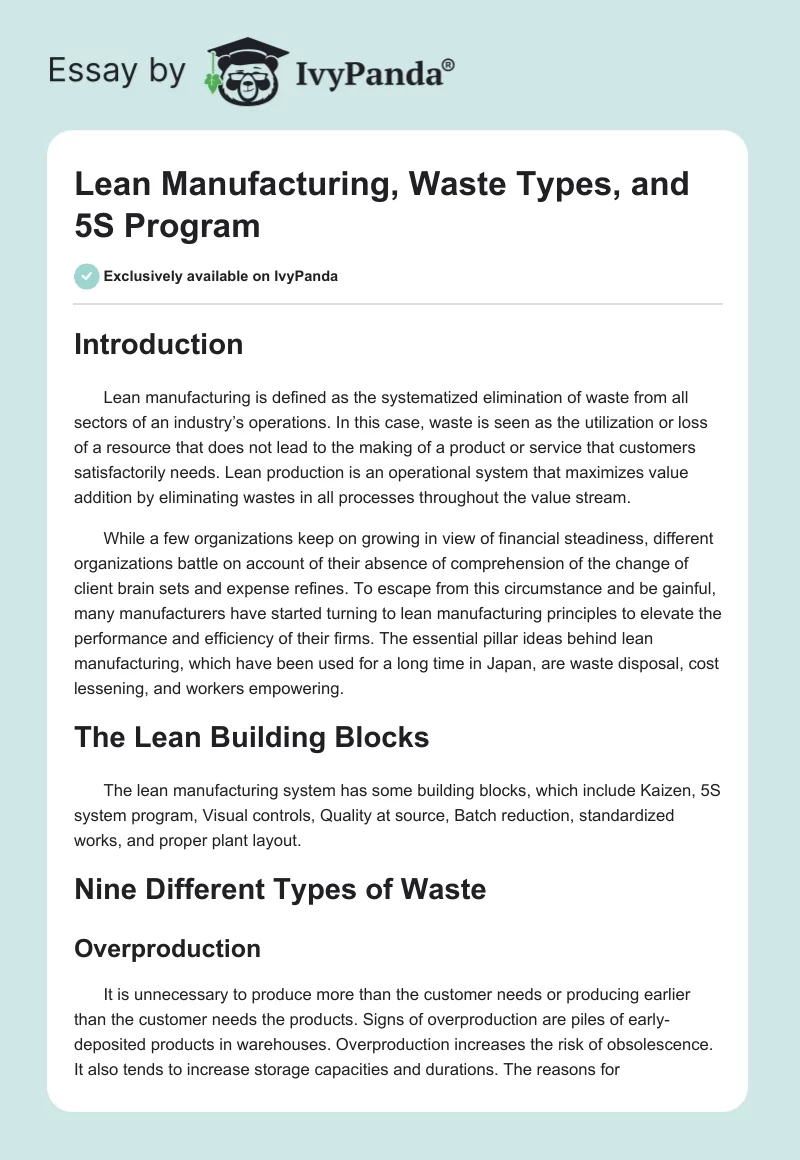Introduction
Lean manufacturing is defined as the systematized elimination of waste from all sectors of an industry’s operations. In this case, waste is seen as the utilization or loss of a resource that does not lead to the making of a product or service that customers satisfactorily needs. Lean production is an operational system that maximizes value addition by eliminating wastes in all processes throughout the value stream.
While a few organizations keep on growing in view of financial steadiness, different organizations battle on account of their absence of comprehension of the change of client brain sets and expense refines. To escape from this circumstance and be gainful, many manufacturers have started turning to lean manufacturing principles to elevate the performance and efficiency of their firms. The essential pillar ideas behind lean manufacturing, which have been used for a long time in Japan, are waste disposal, cost lessening, and workers empowering.
The Lean Building Blocks
The lean manufacturing system has some building blocks, which include Kaizen, 5S system program, Visual controls, Quality at source, Batch reduction, standardized works, and proper plant layout.
Nine Different Types of Waste
Overproduction
It is unnecessary to produce more than the customer needs or producing earlier than the customer needs the products. Signs of overproduction are piles of early-deposited products in warehouses. Overproduction increases the risk of obsolescence. It also tends to increase storage capacities and durations. The reasons for overproduction are the exploitation of automation, long process setup, unbalanced workload, misunderstood communications, and unreliable shipment or delivery by suppliers.
Defects
On top of the physical defects which increase the costs of goods sold, defects can also occur in the form of errors in paperwork and late delivery. Unfortunately, when defects take place, a rework is required sooner than later; otherwise, the product will be rendered as a waste. Defects do not only waste material and labor but also result in a material shortage and create idle time at the subsequent workstations. The major causes that lead to defects include weak process control, misdirecting data, and lack of preparation of the laborers. The waste of defects should be avoided as much as possible since it is better to prevent defects than try to detect them.
Transportation waste
It includes any movements in the workstations that add zero value to the production of goods and services. In fact, it entails transportation between processing stations resulting in prolonged production cycle times. Most movements within the factory are viewed as wastes. The two main causes of transportation waste include poor plant layout and poor knowledge of production process flow.
Excessive resource wastes (reserves)
The surplus is quite akin to the over manufacturing wastes. The supply of excess materials leads to the waste of unnecessary inventory. Excessive reserves lead to higher defects rates, extend lead-period, prevent rapid documentation of hitches, and increase the storage area requirements.
Idle materials
The situation of having materials sitting around in a process without any value addition is a waste. The major causes of this waste are unbalanced workload, unplanned maintenance, poor suppliers, and upstream quality problems.
Waiting
The waste is the idle time by workers or machines due to inefficient production flow in the industry. The waiting period during production may be either observable or unseen. Any moment people queue up or form groups, a waste of time could be taking place that should be avoided. Waiting is a productivity killer and a major source of customer dissatisfaction. It matters not if the waiting occurs in the manufacturing area, hospitals, or the airport. Waiting stinks thus should be eliminated as soon as detected.
Motion
The waste is the most probable misunderstood type of waste, for it is often likened to waste of transportation. Nevertheless, waste of motion entails individuals moving from one place to another but hardly adds worth to the manufactured goods and commodities are given. A common example is how day office workers are forced to walk from their desks to the shared printer. The major cause of motion waste is poor workstation layout or plan.
Waste of inappropriate processing
Sometimes, this kind of waste is confused with overproduction. Inappropriate processing, which is also known as over-processing, is the usage of irrelevant techniques, overcapacity equipment, working with tolerances that are very tight, and performing processes that are unrequired by the customer. All these causes cost us time and money.
Energy waste
It involves the usage of excess energy by people and machines than is actually required to build the product that satisfies the consumer. Major causes of the waste of energy are oversized or poorly maintained machines and poor workplace organization.
The Elements of a 5S Program
The “5S” elements of lean manufacturing are a set of techniques that provide a standard approach to the elimination of wastes in manufacturing industries. The 5S elements include:
Sorting
The element is achieved by keeping only the necessary substances in the workplace. Read tagging every unneeded element and moving them out to an established confinement area is necessary.
Setting in order
The second step or element is where you arrange items while labeling them to promote efficient workflow. In fact, it entails putting everything in order.
Sweeping or Shining
In this element, you clean the work area so that it is neat and tidy. The responsibility here is to conserve a sparkling atmosphere as a constant and unremitting platform.
Standardizing
The element entails maintaining the first three S-element concepts for a consistently organized workplace.
Sustaining
It entails firm devotion to the five-S values via communicating, exercising, and willpower.

 4.00
4.00
